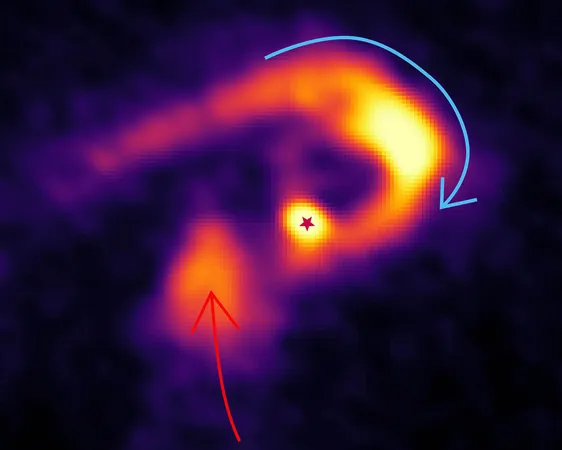
Astounding Discovery: How High-Mass Stars Are Growing Bigger and Faster Than Ever!
2025-08-24
Author: Mei
Astronomers have long been puzzled by the rapid growth of high-mass stars, which form in turbulent environments. Despite intense radiation and powerful stellar winds that should strip them of the fuel needed for growth, these celestial giants continue to expand at an astonishing rate.
A groundbreaking study led by Fernando A. Olguin from Kyoto University has shed new light on this enigma, revealing a novel mechanism that could explain how these massive stars bulk up so quickly.
Streaming Gas: A Stellar Highway
Using the Atacama Large Millimeter/submillimeter Array (ALMA) in Chile, the research team examined a young protostar known as G336.018-00.827 ALMA1. Their observations unveiled not one, but two streams of gas converging towards this stellar formation, with one stream showing striking signs of rotation and infall.
While scientists initially expected to see a large, sprawling accretion disk, they were surprised to find compact spiral arms leading inward and a disk that is likely less than 5.6 billion miles wide.
Gas Streamers: The Key to Growth Remains!
Astronomers categorize high-mass stars as those that exceed eight solar masses. In the realm of massive protostars, traditional models fail to explain the observed behaviors. However, the findings suggest that these long, narrow gas streams—akin to cosmic highways—are crucial in channeling material directly to where it’s needed most.
These gas streamers not only enhance growth but also provide a steady supply of material that counteracts the effects of radiation pressure. The researchers found that one particularly powerful streamer carried enough gas to shield the inner region of the star from being stripped of fuel.
Revolutionary Insights from ALMA
ALMA’s high-resolution capabilities allowed the team to observe intricate details of the gas flows surrounding the protostar, mapping dust emissions and molecular movements that indicate rapid rotation and infall. This data revealed the dynamics of gas as it approaches the center, transitioning from infall to rotational motion.
The observations demonstrated that these gas streams maintain a critical velocity, overwhelming local radiation forces and ensuring that accretion continues despite the extreme conditions.
Challenging Old Theories
This discovery sparks a paradigm shift in our understanding of high-mass star formation. Instead of relying solely on large accretion disks, astronomers now recognize the potential for smaller disks supplemented by powerful gas streamers. This finding could help resolve longstanding questions about how early-stage radiation pressure influences mass delivery to growing stars.
What’s Next for Astronomical Research?
The team aims to extend this research by investigating other stellar regions to determine how often this streaming phenomenon occurs. Further investigations will also explore the possibility of tiny disks that were previously undetectable.
With this pivotal study published in 'Science Advances,' the astronomical community is eager to learn more about the processes behind the formation of massive stars and the role that these gas highways play in their development.
Stay tuned as we unveil more revelations from the cosmos, and don't miss out on our newsletter for the latest updates from the world of astronomy!




 Brasil (PT)
Brasil (PT)
 Canada (EN)
Canada (EN)
 Chile (ES)
Chile (ES)
 Česko (CS)
Česko (CS)
 대한민국 (KO)
대한민국 (KO)
 España (ES)
España (ES)
 France (FR)
France (FR)
 Hong Kong (EN)
Hong Kong (EN)
 Italia (IT)
Italia (IT)
 日本 (JA)
日本 (JA)
 Magyarország (HU)
Magyarország (HU)
 Norge (NO)
Norge (NO)
 Polska (PL)
Polska (PL)
 Schweiz (DE)
Schweiz (DE)
 Singapore (EN)
Singapore (EN)
 Sverige (SV)
Sverige (SV)
 Suomi (FI)
Suomi (FI)
 Türkiye (TR)
Türkiye (TR)
 الإمارات العربية المتحدة (AR)
الإمارات العربية المتحدة (AR)